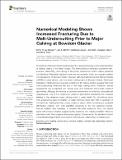Files in this item
Numerical modeling shows increased fracturing due to melt-undercutting prior to major calving at Bowdoin Glacier
Item metadata
| dc.contributor.author | van Dongen, Eef C. H. | |
| dc.contributor.author | Åström, Jan A. | |
| dc.contributor.author | Jouvet, Guillaume | |
| dc.contributor.author | Todd, Joe | |
| dc.contributor.author | Benn, Douglas I. | |
| dc.contributor.author | Funk, Martin | |
| dc.date.accessioned | 2020-07-16T09:30:11Z | |
| dc.date.available | 2020-07-16T09:30:11Z | |
| dc.date.issued | 2020-07-14 | |
| dc.identifier | 269172331 | |
| dc.identifier | 97142180-ae25-4a21-9a65-5c86f0de9bae | |
| dc.identifier | 85088792129 | |
| dc.identifier | 000556571000001 | |
| dc.identifier.citation | van Dongen , E C H , Åström , J A , Jouvet , G , Todd , J , Benn , D I & Funk , M 2020 , ' Numerical modeling shows increased fracturing due to melt-undercutting prior to major calving at Bowdoin Glacier ' , Frontiers in Earth Science , vol. 8 , 253 . https://doi.org/10.3389/feart.2020.00253 | en |
| dc.identifier.issn | 2296-6463 | |
| dc.identifier.other | RIS: urn:73F227FAAEAB00AC482DFEB5671AFC60 | |
| dc.identifier.other | ORCID: /0000-0002-3604-0886/work/77524528 | |
| dc.identifier.other | ORCID: /0000-0003-3183-043X/work/77525212 | |
| dc.identifier.uri | https://hdl.handle.net/10023/20268 | |
| dc.description | This research was part of the Sun2ice project (ETH Grant ETH-12 16-2), supported by the Dr. Alfred and Flora Spälti and the ETH Zurich Foundation. Fieldwork was funded by the Swiss National Science Foundation, grant 200021-153179/1. The HiDEM simulations were performed under the Project HPC-EUROPA3 (INFRAIA-2016-1-730897), with the support of the EC Research Innovation Action under the H2020 Programme; in particular, the authors gratefully acknowledge the computer resources and technical support provided by CSC-IT Centre for Science in Finland. DB and JT were funded by NERC grant NE/P011365/1 (CALISMO: Calving Laws for Ice Sheet Models). | en |
| dc.description.abstract | Projections of future ice sheet mass loss and thus sea level rise rely on the parametrization of iceberg calving in ice sheet models. The interconnection between submarine melt-induced undercutting and calving is still poorly understood, which makes predicted contributions of tidewater glaciers to sea level rise uncertain. Here, we compare detailed 3-D simulations of fracture initiation obtained with the Helsinki Discrete Element Model (HiDEM) to observations, prior to a major calving event at Bowdoin Glacier, Northwest Greenland. Observations of a plume surfacing at the calving location suggest that local melt-undercutting influenced the size of the major calving event. Therefore, several experiments are conducted with various local and distributed (front-wide) undercut geometries. Although the number of undercut experiments is limited by computational requirements, one of the conjectured undercut geometries reproduces the crevasse leading to the observed major calving event in great detail. Our simulations show that undercutting leads to initiation of wider fractures more than 100 m upstream of the terminus, well-beyond the directly undercut region. When combining a moderate distributed undercut with local amplified undercuts at the two observed plumes, fracture initiation also increases in between the local undercuts. Thus, our results agree with previous studies suggesting the existence of a “calving amplifier” effect by submarine melt, both upglacier and across-glacier. Consequently, the simulations show the potentially large impact of submarine melt-induced undercutting on iceberg size. | |
| dc.format.extent | 2745368 | |
| dc.language.iso | eng | |
| dc.relation.ispartof | Frontiers in Earth Science | en |
| dc.subject | Glacier modeling | en |
| dc.subject | Iceberg calving | en |
| dc.subject | Numerical modeling | en |
| dc.subject | Submarine melt | en |
| dc.subject | Undercutting | en |
| dc.subject | Crevasses | en |
| dc.subject | Northwest Greenland | en |
| dc.subject | G Geography (General) | en |
| dc.subject | DAS | en |
| dc.subject.lcc | G1 | en |
| dc.title | Numerical modeling shows increased fracturing due to melt-undercutting prior to major calving at Bowdoin Glacier | en |
| dc.type | Journal article | en |
| dc.contributor.sponsor | NERC | en |
| dc.contributor.institution | University of St Andrews. School of Geography & Sustainable Development | en |
| dc.contributor.institution | University of St Andrews. Bell-Edwards Geographic Data Institute | en |
| dc.contributor.institution | University of St Andrews. Environmental Change Research Group | en |
| dc.identifier.doi | 10.3389/feart.2020.00253 | |
| dc.description.status | Peer reviewed | en |
| dc.identifier.grantnumber | NE-P011365/1 | en |
This item appears in the following Collection(s)
Items in the St Andrews Research Repository are protected by copyright, with all rights reserved, unless otherwise indicated.

